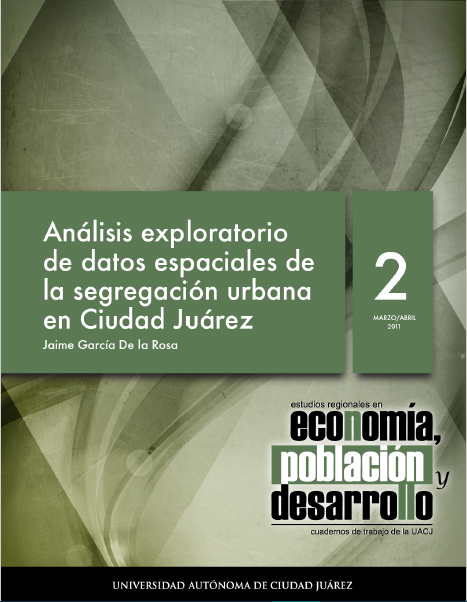Análisis exploratorio de datos espaciales de la segregación en Ciudad Juárez
DOI:
https://doi.org/10.20983/epd.2011.2.1Palabras clave:
segregación espacial, desarrollo urbano, Ciudad Juárez, MéxicoResumen
Este trabajo presenta un análisis sobre la segregación espacial en Ciudad Juárez. A partir de un modelo econométrico se revisa un estudio previo sobre la segregación en esta ciudad fronteriza del norte de México. Para realizar esta exploración se utilizó el software GeoDa, el cual es desarrollado por GeoDa Center for Geospatial Analysis and Computation de la Universidad del Estado de Arizona, y el cual proporciona tanto indicadores globales espaciales como locales que permiten concluir la existencia de un patrón espacial y de qué tipo es. En este trabajo se confirma la segregación espacial en Ciudad Juárez y se ofrece una metodología que da mayor sustento a otros estudios previos y futuros en este campo.
Citas
Anas, Alex, Richard Arnott (1998), and Kennet Small. "Urban Spatial Structure". Journal of Economic Literature 36, no. 3, pp. 1426-1464.
Anselin, Luc (1993). "Exploratory Spatial Data Analysis and Geographic Information Systems". Workshop on New tools for spatial analysis, pp. 1-17.
Anselin, Luc (1995). "Local Indicators of Spatial Association-LISA." Geographical Analysis, pp. 93-115. Anselin,Luc (1993)". "The Moran Scatterplot as an ESDA Tool to Asses Local Instability in Spatial Association". Spatial Analytical Perspectives on GIS, pp. 111-125.
Clark, W, y W Van Lierop (2000). "Residential Mobility and Household Location Modeling". En Hanbook of Regional and Urban Economics, de Peter Nijkamp, 97-132. Amsterdam: Elsevier Science. B.V.
Elbers, Chris, Jean Lanjouw, and Peter Lanjouw (2003). "Micro-Level stimation of Poverty and Inequality." Econometrica, pp. 355-364.
Feitosa, Flavia, Gilberto Camara, Antonio Monteiro, Thomas Koschitzki, and Marcelino Silva (2007). "Global and Local Spatial Indices of Urban Segregation". International Journal of Geographical Information Science 21, no. 3, pp. 299-323.
Fuentes, César, and Luis Cervera (2006). "Land Market and its Effects on the Spatial Segregation: The Case of Ciudad Juárez Mexico". Estudios Fronterizos 7, no. 3, pp. 46-65.
INEGI (2000). "XII CENSO de población y vivienda."
Jargowsky, Paul, and Jeongdai Kim (2005). "A Measure of Spatial Segregation: The Generalized Neighborhood Sorting Index." National Poverty Center Working Paper Series,pp. 1-48.
Myint, Soe (2008). "An exploration of spatial dispersion, pattern, and association of socio-economic functional units in an urban system." GeoDa Center Working Paper 2008-3, pp. 1-56.
Reardon, Sean, and David O'Sullivan (2004). "Measures of spatial segregation." Sociological Methodology, pp. 121-162.
Sethi, Rajiv, and Rohini Somanathan (2004). "Inequality and Segregation." The Journal of Political Economy 112, no. 6, pp. 1296-1321.
Wassmer, Robert (2005). "An Economic View of Some Causes of Urban Spatial Segregation and its Costs and Benefits." In Desegregating the City: Ghettos, Enclaves and Inequality Nueva York: State University of New York.
Watson, Tara, Gerald Carlino, and Ingrid Ellen (2006). "Metropolitan Growth, Inequality, and Neighborhood Segregation by Income". Brookings-Wharton Papers on Urban Affairs, pp. 1-52.
Wong, David (2004). "Comparing traditional and spatial segregation measures: a spatial scale perspective." Urban Geography, pp. 66-82.
Zax, Jeffrey (2003). "Residential Location Theory and the Measurement of Segregation." Annales D'Économie et de Statistique, pp. 189-219.




